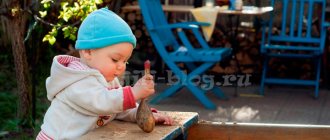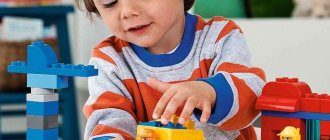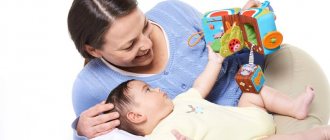Sometimes, sitting down with the baby, we think, “Well, we should do something useful, developmental,” and begin to delve into the depths of our memory, remembering what interesting things were written in books and on forums. But while we are thinking, the child is already crawling away from us and, having climbed somewhere, throws us new troubles. So the right moment is missed, and we again postpone the “development” until next time. To avoid this situation, you simply need to have a PLAN at hand! A plan of developmental activities can always quickly tell us how to entertain the baby in an interesting and useful way.
In this article, I want to share a comprehensive development plan for 9-12 months, which I drew up for my daughter, and which helped us brighten up the gray days. This program has everything for the comprehensive development of a child. The program will help you choose educational toys appropriately for your child’s age and organize activities so that they meet the child’s cognitive needs at a specific period.
I have already mentioned all these classes before in my articles, but here is a short summary without unnecessary words, which is convenient to look into if necessary, you can say a summary of the classes. If you want to read more about each game, click on the title link.
By the way, similar notes for classes and games for other periods of development can be found here:
READY PROGRAMS FOR DEVELOPMENTAL ACTIVITIES
So, educational games with a child 9 months and older (detailed plan):
Games to develop sensorimotor skills
- We string/remove rings from the pyramid (in any order) (to read a detailed description of the game, follow the link)
- We put/put out small items from a box or other container;
- Open/close boxes, jars, nesting dolls;
An example of a nesting doll (Labyrinth, My-shop, KoroBoom)
- We knock objects against each other;
- We stack the cubes on top of each other;
- We roll the car;
- We play with small objects (take them out of the sensory box, put them in a jar);
- Playing with sensory boxes;
- We master the first instrumental actions (we learn to pour sand into a bucket with a scoop, knock with a hammer);
Example of a knocker (Ozon, My-shop, KoroBoom)
- We play with a ball thrower/sorter;
- Playing with cereals/sand;
- We learn to turn on/off lights and buttons on musical toys;
- Let's get acquainted with the concepts of “big-small”;
Emotional and psychological aspects
Games with a 9-month-old baby are becoming more varied than before. At this age, you can draw with your baby, play with blocks, study colors, and assemble construction sets. Important elements of psychological development are fine motor skills. There is a scientifically proven connection between speaking and finger skills. We already talked about this earlier.
Early development complexes include various games to improve fine motor skills. At home, you can do this by sorting various products. For example, mix pasta and nuts in a container. The child needs to learn to distinguish and separate elements. In such situations, it is very important to ensure that the baby does not put objects in the ears, nose and mouth.
Drawing captivates children for a long time. In addition, such activities develop imagination. It should be noted that a nine-month-old baby is not able to hold a pencil or brush. However, this is not scary at all; you can use zipper bags and gouache. You need to pour a little different paints into the bag, pour in the cereal and close the lock. Then glue it to the floor with tape.
The baby will be happy to smear the paint all over the bag, developing his fingers and learning new colors. The big advantage for mom is that the surroundings will be clean.
Games with paper are very useful. When a child crumples or tears it, the parts of his brain that are responsible for motor skills and coordination are activated.
Speech development
- We talk a lot with the baby;
- We tell the baby rhymes and nursery rhymes;
- We are learning the first finger and gesture games;
- We expand the baby’s passive vocabulary (we give a “tour” around the house, name new objects during a walk, study parts of the face and body);
- We introduce the baby to onomatopoeic words (we remember how different animals say (mu, woof, be, etc.), what it sounds like (bell - ding-ding, car - beep, etc.))
- We arrange “roll calls”, repeating simple syllables with the baby
Baby's achievements by nine months of age
A nine-month-old child already has certain sensory-motor capabilities. Some of them:
- grasps large objects with two hands, brings them closer to him and examines them closely;
- manipulates several toys;
- gets to his feet with the help of adults;
- clapping hands;
- takes small objects in one hand;
- crawls and is able to change direction 180°.
Similar skills can be trained using a doll. You need to take her and show the child how she walks, goes to bed, gets on her feet and eats. All manipulations can be accompanied by stories about the doll’s actions - this will arouse interest in both girls and boys. It is very good if the baby tries to take the toy and play with it on his own. Key aspects to consider:
- Monotonous situations are not interesting to the baby.
- You can play simple hide and seek with your 9 month old baby.
- The child understands what adults are telling him, that is, in the process of communication he develops an inactive vocabulary.
- The baby responds to requests and tries to fulfill them.
- Children remember the games they played yesterday.
- Some may be afraid of open areas and climbing to heights.
- The baby repeats words consisting of two syllables.
- Makes attempts to explain something to an adult using gestures. For example, when a baby doesn’t want to eat, he shows it by turning his head away.
From all this it follows that a baby’s abilities at the age of 9 months relate to communication with others and the beginning of the use of speech. In order for a baby to speak correctly, adults must communicate with him clearly and legibly, without distorting his speech. You should take control of your facial expressions and not make unnecessary gestures - this complicates the perception of information.
Thus, the famous pediatrician Evgeny Komarovsky believes that a nine-month-old child experiences a breakthrough in behavior - he becomes energetic and can express his passions. However, the doctor emphasizes that if the baby doesn’t know how to do something, there is no need to be upset, because this is not an indicator. He will be able to learn everything, only a little later. There have been cases when capable and future successful children did not speak until they were 3 years old. It is very important to spare no effort and spend a lot of time with your child.
Daily regime
The child can already stay awake for a long time, exploring everything around him. At night, the 9-month-old baby often sleeps without waking up. The total sleep duration of a child of this age is up to 15 hours. Night sleep lasts an average of 10 hours, and during the day the child sleeps twice for 1.5-2.5 hours.
You should walk with a child at the age of nine months twice a day - in the morning (at about 10-11 o'clock) and in the afternoon (at about 16-17 o'clock). If the weather is good, both naps during the day should be organized during a walk. In summer, it is recommended to spend more time outside, using access to fresh air to sleep, to study nature, and to harden up.
A 9-month-old baby's diet includes 5 meals. The break between them is from 3.5 to 4 hours. The child should eat food at approximately the same time, and should not be rushed or forced. Breastfed babies receive mother's milk at the first feeding in the morning, before naps and after waking up, at night, and also at night. Formula-fed babies continue to receive an adapted formula at their first and fifth feedings.
There are already quite a lot of complementary foods on the baby's menu. At 9 months of age, breastfed babies begin to be given cottage cheese, fermented milk complementary foods, yolk and milk porridge. Artificial children are already familiar with these products, so their diet at this age is expanded only through new combinations of already introduced products.
The total amount of food for a nine-month-old child that he eats per day is determined by dividing the toddler’s body weight by 9. On average, children of this age eat from 1000 to 1200 ml of food per day, which is about 200-240 ml of food per feeding.
Hide and seek
A child’s ability to remember the place where he just saw your head hiding from him makes the game of hide and seek one of his favorites. Give your child the opportunity to chase you behind the sofa. After a little while, look out from behind the sofa and call him. The baby will happily crawl to the place where you were looking out from. Sometimes he begins to imitate your movements, also hiding and peeking out from behind the sofa.
Make the game more difficult. Hide and, without looking out, call the baby. Watch as he begins to look for the place where the voice comes from, evoking your image in his memory. Remind yourself often to keep your child interested in the search.
New level of the game. Throw a scarf over your face or hide behind some cardboard and ask: “Where is mommy?” By opening your face or allowing your baby to pull off his scarf, your appearance will cause delight and happy children's laughter. Now, on the contrary, hide the child under the diaper and ask: “Where is the baby?” When he pulls off the diaper, you exclaim, “Here he is!”
This game is good for developing memory in children. When you disappear, his memory retains your image, and when you appear again, the baby experiences genuine joy from the coincidence of this image and your appearance in reality.
Games with a child 9-12 months. Photo by Meghan Thompson on Unsplash
Interesting items
Many parents, in an attempt to interest their child, buy many different toys. It is important to note that there does not have to be a lot of them; it is quite enough so that they correspond to the age of the baby. So, to conduct educational games for children at 9 months , you will need the following items:
- Pyramid. Having learned to fold it once, the child will definitely want to do it again. When choosing, you need to pay attention to the stability of the toy. In addition, the elements should be easy to put on and take off. If the structure constantly falls or is difficult to assemble, the baby will quickly lose interest in it.
- Rubber ball. At this age, outdoor games contribute to the development of dexterity and coordination.
- Wind-up toys. The baby will quickly figure out what manipulations need to be done to make the car move or the dog to nod its head.
- Figurative toys. A variety of dolls and animals made from various materials help the baby imagine the world around him. With their help you can play hide and seek, stage plays, etc.
- Your child will really like finger paints. They are hypoallergenic, non-toxic, and made from safe ingredients. In addition, they are easy to wash off, so mom doesn’t have to worry about the baby getting dirty or damaging the furniture. You need to allow the baby to choose a color on his own, and then teach him to draw a sun, a ball and any other simple details.
- The baby will like modeling dough much more than regular plasticine. This dough can be cut, kneaded by hand, placed in a jar and made into various animals.
- Cubes. At 9 months, the baby is not able to build a castle, but he can quite easily make a high tower. You need to teach him how to place parts on top of each other, and then have fun destroying the structure with one movement.
Basic Rules
When the baby begins to move independently, adults will no longer have to think about what to do with a 9-month-old child at home. He will be able to entertain himself while studying surrounding objects. It is very important for parents to follow certain rules:
- Provide your baby with as much play space as possible. You should try to lock him in a high chair or bed less often. He needs to learn to move, thereby improving dexterity and coordination.
- Wash floors thoroughly with disinfectants and constantly treat toys with boiling water. Children at this age love to try everything.
- Secure your home. It is necessary to hide medicines and other dangerous objects from the baby. It is advisable to handle sharp corners using overlays and insert special plugs into sockets.
- You can’t say “no” to your child often. This can discourage your baby from craving for new sensations and knowledge. It is advisable to remove prohibited items in advance or distract the baby with an interesting toy.
- Children should not be left alone unattended. At this age they are very inquisitive, so they can get anywhere in a few minutes.
- Experts recommend equipping a small play corner in each room. So, in the kitchen you can install a small box with toy dishes. While the baby is studying objects, mom can calmly prepare food.











